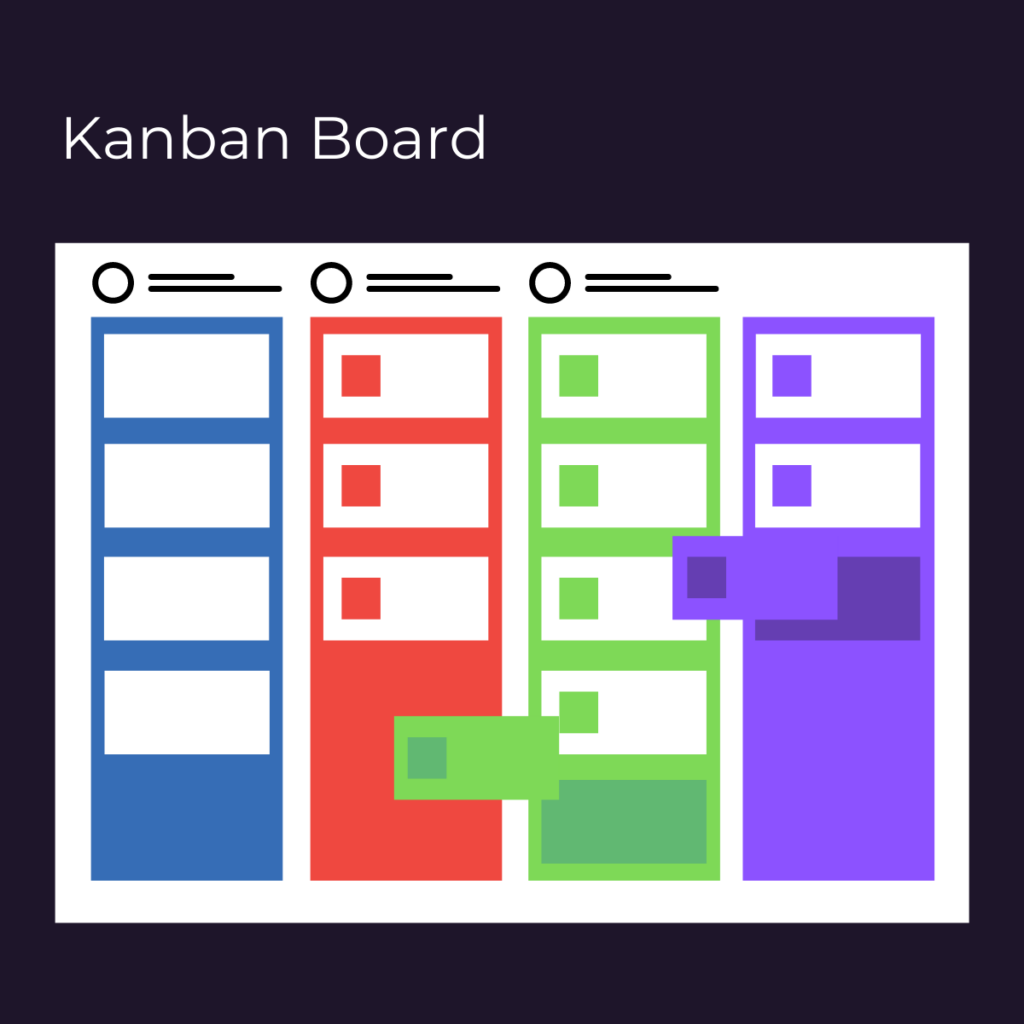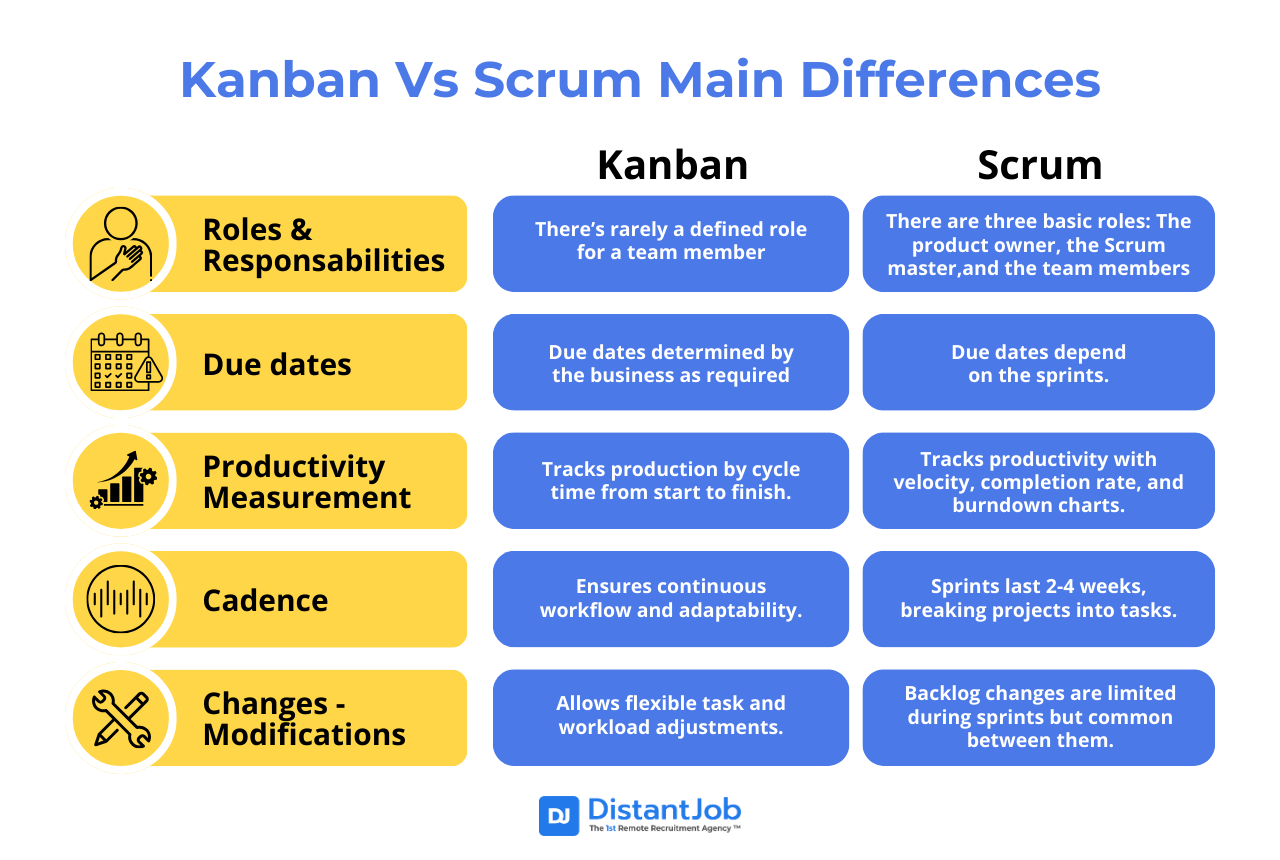Choosing which methodology is more useful to implement on your team can be as challenging as choosing which Star Wars movie is the best one. Kanban and Scrum have proven to be great frameworks for all kinds of teams (remote, non-remote, and especially hybrid) to work with if used correctly. Both have different approaches to help teams organize and work in the same direction overall. But which one is better? What are the advantages of Kanban, and what are the advantages of Scrum? Let’s dive deep into analyzing the Kanban vs. Scrum methodology.
What is Kanban?
Kanban is a workflow management method inspired by Toyota’s Kanban, made by Taiichi Ohno, an industrial engineer at Toyota looking for ways to improve Toyota’s manufacturing process. Toyota’s Kanban and the Kanban Agile framework are very different, so let’s focus on the one we will use.
This methodology aims to visualize work and maximize its efficiency, used across different types of industries. Teams using this method focus on reducing the time it takes to make a project from start to finish.
For those wondering, Kanban (Japanese word) means billboard or signboard.
Kanban adheres to the six principles below:
1. Visualize the workflow
Observing the current workflow helps visualize how tasks are progressing or the roadblocks that need to be solved to move forward.
2. Limit work in progress
This principle’s objective is for teams to complete their current work before moving to the next task.
3. Manage flow
This principle defends the anti-micromanaging movement. Managing the workflow means managing the work but not the people. Teams should focus mainly on managing the work processes and finding ways to improve and make that work faster.
4. Make process policies explicit
Every member of the team should be aware of the policies, rules, processes, and guidelines. That way, misunderstandings and conflicts within the group are avoided, and teams cooperate because everyone knows what to do.
5. Feedback loops
Feedback loops are an essential part of Kanban. They consist of short daily meetings in which members of the team tell others what they did the previous day and what their plans are for today. This way, team members and stakeholders are aware of what everyone is doing or if they need help with something.
6. Improve collaboratively
One of Kanban’s ultimate goals is helping teams to deliver projects faster and reliably. Teams that understand their goals, workflow, and processes are more likely to solve problems efficiently and work together to improve continually. It all relies on making stronger, faster, and united teams by changing their perception of working on a project collaboratively.
Implementing the Kanban Methodology
Kanban’s aim to visualize projects takes place through a board. Kanban boards include cards representing a single task that moves through diverse project stages. Besides cards, the board also has columns (usually To-Do, In-Progress, and Done), WIP (Work in Progress) limits, commitment points, and delivery points.
Kanban’s board might be either physical or virtual. Some on-site companies use whiteboards and put post-its on them. Other teams use different types of boards, but overall, they all look like this:

If you are wondering why to choose Kanban, it depends on how your team works. But overall, Kanban is an excellent methodology for remote teams. Although on remote means you can’t have a physical board, you can have a virtual one. With platforms such as Trello, you can adapt it to the Kanban model. For example, we use a Trello board in our content marketing team that helps us organize and visualize our current tasks and the upcoming tasks better.
Kanban Pros and Cons
| Pros | Cons |
| Focuses on continuous delivery | Teams can overcomplicate the board with many statuses and columns |
| Increases productivity and efficiency | Lacks schedule management |
| Reduces the time cycle of the process | Lack of documentation |
| Easy methodology to implement | Lack of predictability (hard to foresee deadlines, requires discipline) |
| Flexible methodology | Has to be constantly updated |
| Improves the delivery flow | Limited plan structure |
(Just a friendly reminder that any Cons in Kanban or Scrum are easily mitigated by applying good practices from other frameworks. ☺️)
What is Scrum?
Scrum is an Agile framework f that helps teams to develop and deliver complex products. It was first implemented in software development, but it has been used in other fields as well. The term Scrum comes from rugby, where a scrum consists of a formation of players. It emphasizes teamwork.
Scrum encourages teams to self-organize and collaborate while working on a project. And to continuously seek improvement by reflecting on their wins and losses.
How Does Scrum Work?
The Scrum framework has a process with several elements that guide the team to complete their project. First, it’s important to understand that a team works in a series of iterations called sprints. A sprint is a time-boxed period in which a Scrum team works to complete determining work objectives. It’s meant to deliver an incremental value every sprint, instead of finishing the product in a short amount of time. Each sprint (or iteration) consists of:
1) Sprint planning
It’s a team meeting where all the members plan and decide what to complete in the sprint. The final objective of the sprint planning is for development teams to answer:
What work can be done in this sprint? How to execute the chosen work?
Teams focus on these specific aspects for the sprints to be clear for each member of the team:
- What: The owner of the product describes what the goal of the sprint is.
- How: The development team plans the work necessary to achieve the sprint goal and create your dream app.
- Who: Sprint plannings involve both the product owner and the development team. The product owner defines the goal they seek, and the team decides if they can or can’t deliver that goal.
- Inputs: Teams start analyzing the product backlog as this provides a list of things that could potentially be part of the current sprint.
- Outputs: The team should describe at the end of the sprint planning meeting the goal of the sprint, and how they will start working towards that goal.
2) Daily stand-ups
Like the feedback loops in Kanban, a daily stand-up means a short meeting where each member of the team shares:
- Tasks worked on yesterday
- What’s their plan for today
- If they are having any difficulty
The standup’s objective is for the team to sync and be aware of what teammates are up to and to see a wider picture of how the sprint is evolving.
3) Sprint demo
It consists of a sprint review where the finished product backlog items are shown. Each member of the team demonstrates with informal demonstrations, the work they’ve done for the sprint. In this meeting, members usually give feedback, ask questions, and make proposals to try new features.
4) Sprint retrospective
A final review of what worked and what didn’t to improve the upcoming sprints. The meeting aims for the team to reflect on the past sprint, identify the strengths and weaknesses, and clarify what aspects they should improve for the upcoming sprint.
Roles in Scrum
Unlike Kanban, Scrum does differentiate roles during the sprint’s processes. There are three basic roles:
- Product owner: Determines what needs to be done and sets priorities in the product backlog, taking into account the stakeholders’ needs and feedback.
- Scrum master: Facilitates the scrum process, assigns tasks and due dates. He is in charge of the tools and environment to make the sprint happen easily.
- Scrum team: Several individuals working together and determining the best approaches to deliver and achieve the objectives set during the sprint planning.
Scrum Pros and Cons
| Pros | Cons |
| It’s collaborative | It involves many meetings |
| Makes large projects easier by dividing them into sprints | Requires an Agile company, not just the team |
| Continues feedback that helps improving future products | Needs a committed team for the assigned tasks |
| By working on sprints, teams can catch mistakes before release | It’s hard to scale up |
| Budget-friendly and get fast results | It’s mostly suitable for small teams |
| It’s easier for teams to make changes | It’s not micromanaging friendly |
What is the Difference Between Scrum and Kanban?
Scrum focuses on work cycles to deliver incremental value, while Kanban focuses on a continuous workflow.
We’ve seen what each methodology is about, its advantages and disadvantages, and how they work on teams. Both are different methodologies that work effectively, depending on your team’s objectives.
On the infographic below are the main differences that might help you decide why to choose one over the other:

Who Wins the Battle: Kanban or Scrum?
When analyzing Scrum vs. Kanban, you’ll see there is no winner. Both methodologies can help teams to finish projects and reach the desired results successfully. It depends on how well the methods are implemented, but mostly on what your objectives are. Nowadays, some teams are even working with both methodologies, calling it: Scrumban, a framework that combines the best features of both. We do recommend that before deciding to analyze the projects you need to finish, as well as to know well how your team works.
If you are still unsure which option is better for your company, contact us. We will gladly help you with your company’s needs!




